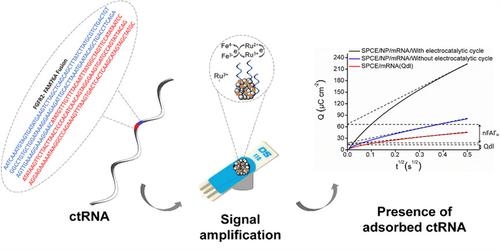当前位置:
X-MOL 学术
›
Electroanalysis
›
论文详情
Our official English website, www.x-mol.net, welcomes your
feedback! (Note: you will need to create a separate account there.)
Detection of FGFR2:FAM76A Fusion Gene in Circulating Tumor RNA Based on Catalytic Signal Amplification of Graphene Oxide-loaded Magnetic Nanoparticles
Electroanalysis ( IF 2.7 ) Pub Date : 2018-07-04 , DOI: 10.1002/elan.201800282 Lena Gorgannezhad 1, 2 , Muhammad Umer 2 , Mostafa Kamal Masud 2, 3 , Md. Shahriar A. Hossain 3 , S. Tanaka 4 , Y. Yamauchi 3, 4, 5 , Carlos Salomon 6, 7, 8 , Richard Kline 8 , Nam-Trung Nguyen 2 , Muhammad J. A. Shiddiky 1, 2
Electroanalysis ( IF 2.7 ) Pub Date : 2018-07-04 , DOI: 10.1002/elan.201800282 Lena Gorgannezhad 1, 2 , Muhammad Umer 2 , Mostafa Kamal Masud 2, 3 , Md. Shahriar A. Hossain 3 , S. Tanaka 4 , Y. Yamauchi 3, 4, 5 , Carlos Salomon 6, 7, 8 , Richard Kline 8 , Nam-Trung Nguyen 2 , Muhammad J. A. Shiddiky 1, 2
Affiliation

|
Circulating tumor nucleic acids (ctNAs) are promising biomarkers for minimally invasive cancer assessment. The FGFR2 : FAM76A fusion gene is one of the highly promising ovarian cancer biomarkers detectable in ctNAs. Herein, we introduce a new amplification-free electrochemical assay for the detection of FGFR2 : FAM76A fusion gene in ctNAs extracted from ovarian cancer patients. The assay relies on the electrocatalytic activity of a new class of superparamagnetic graphene-loaded iron oxide nanoparticles (GO-NPFeO). After isolation and purification, the target RNA was directly adsorbed onto the GO-NPFeO surface through graphene-RNA affinity interaction. The electrocatalytic signal was achieved by the reduction of surface-attached ruthenium hexaammine(III) chloride which was further amplified by using the ferricyanide redox system. Our assay depicted an excellent detection sensitivity down to 1.0 fM, high specificity and excellent reproducibility (% RSD=<5 %, for n=3). The analytical performance of our method was validated with standard qRT-PCR analysis. We believe that this newly developed assay would be practically applicable in clinical research.
中文翻译:

基于氧化石墨烯磁性纳米粒子催化信号放大检测循环肿瘤RNA中FGFR2:FAM76A融合基因
循环肿瘤核酸 (ctNA) 是用于微创癌症评估的有前途的生物标志物。FGFR2 : FAM76A 融合基因是可在 ctNA 中检测到的非常有希望的卵巢癌生物标志物之一。在此,我们介绍了一种新的无扩增电化学检测方法,用于检测从卵巢癌患者中提取的 ctNA 中的 FGFR2:FAM76A 融合基因。该测定依赖于一类新型超顺磁性石墨烯负载氧化铁纳米粒子 (GO-NPFeO) 的电催化活性。分离纯化后,目标RNA通过石墨烯-RNA亲和相互作用直接吸附到GO-NPFeO表面。电催化信号是通过还原表面附着的六氨合氯化钌 (III) 来实现的,该信号通过使用铁氰化物氧化还原系统进一步放大。我们的分析显示出低至 1.0 fM 的出色检测灵敏度、高特异性和出色的重现性(% RSD=<5%,对于 n=3)。我们方法的分析性能通过标准 qRT-PCR 分析进行了验证。我们相信这种新开发的检测方法将实际适用于临床研究。
更新日期:2018-07-04
中文翻译:

基于氧化石墨烯磁性纳米粒子催化信号放大检测循环肿瘤RNA中FGFR2:FAM76A融合基因
循环肿瘤核酸 (ctNA) 是用于微创癌症评估的有前途的生物标志物。FGFR2 : FAM76A 融合基因是可在 ctNA 中检测到的非常有希望的卵巢癌生物标志物之一。在此,我们介绍了一种新的无扩增电化学检测方法,用于检测从卵巢癌患者中提取的 ctNA 中的 FGFR2:FAM76A 融合基因。该测定依赖于一类新型超顺磁性石墨烯负载氧化铁纳米粒子 (GO-NPFeO) 的电催化活性。分离纯化后,目标RNA通过石墨烯-RNA亲和相互作用直接吸附到GO-NPFeO表面。电催化信号是通过还原表面附着的六氨合氯化钌 (III) 来实现的,该信号通过使用铁氰化物氧化还原系统进一步放大。我们的分析显示出低至 1.0 fM 的出色检测灵敏度、高特异性和出色的重现性(% RSD=<5%,对于 n=3)。我们方法的分析性能通过标准 qRT-PCR 分析进行了验证。我们相信这种新开发的检测方法将实际适用于临床研究。











































 京公网安备 11010802027423号
京公网安备 11010802027423号